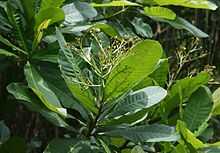Anacardium excelsum
| Wild cashew | |
|---|---|
 | |
| Scientific classification | |
| Kingdom: | Plantae |
| (unranked): | Angiosperms |
| (unranked): | Eudicots |
| (unranked): | Rosids |
| Order: | Sapindales |
| Family: | Anacardiaceae |
| Genus: | Anacardium |
| Species: | A. excelsum |
| Binomial name | |
| Anacardium excelsum L. | |
| Synonyms | |
|
Anacardium rhinocarpus (Kunth) DC. | |
Anacardium excelsum (wild cashew or espavé) is a tree in the flowering plant family Anacardiaceae. The tree is common in the Pacific and Atlantic watersheds of Central and South America, found as far north as Guatemala and extending south into Ecuador.
The wild cashew is a closely related species within the same genus as the cashew. It is a large evergreen tree growing to 45 m tall, with a straight, rose-hued trunk reaching 3 m in diameter. The leaves are simple, alternate, oval-shaped, 15–30 cm long and 5–12 cm broad. The flowers are produced in a panicle up to 35 cm long, each flower small, pale green to white. Older flowers turn pink and develop a strong clove-like fragrance.
The true fruit is a 2–3 cm long drupe shaped like a kidney. Maturation occurs in March, April, and May. When uncooked, the fruit is poisonous. The nut may, however, be eaten after it is roasted.
See also
- Cashew - the cultivated species Anacardium occidentale.
References
![]() Media related to Anacardium excelsum at Wikimedia Commons
Media related to Anacardium excelsum at Wikimedia Commons
![]() Data related to Anacardium excelsum at Wikispecies
Data related to Anacardium excelsum at Wikispecies